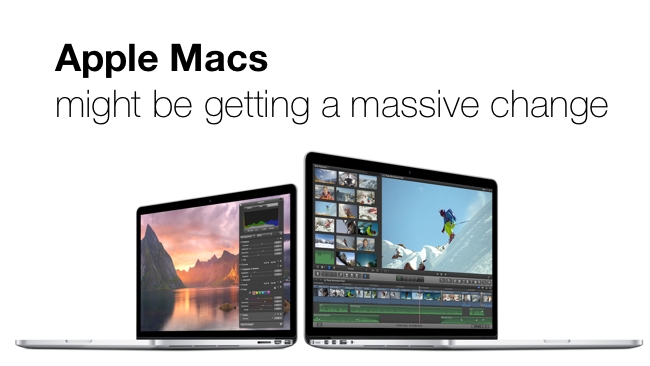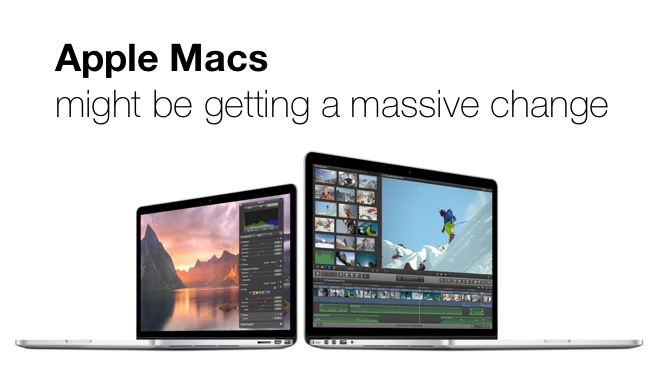
 Apple macs might be getting a massive change
Apple macs might be getting a massive change
Could Apple possibly ditch Intel as its processor chip supplier? What would that mean? And how could it happen?
Ever since Apple started to make its own processor chips for iPhones and iPads there has been speculation that, eventually, these components would end up powering Macs. It’s a reasonable thing to speculate about, given that Steve Jobs was, to put it mildly, fond of being in control. For Apple’s tight and skillfully planned production schedules to be at the mercy of Intel must really rankle.
Not only that, but Intel’s chips are arguably quite expensive. They probably constitute a significant percentage of Apple’s manufacturing costs. In a world of very tight margins, this matters.
Such a radical change of architecture would seem all but impossible if it weren’t for the fact that Apple did exactly the same sort of thing almost ten years ago, when it moved from PowerPC processors to Intel. Rumors of this were abundant in the several years before they did this (I remember writing about it at the time), and the key to the smooth transition was that (again a rumor, never officially confirmed as far as I know) they had a version of OS X up and running on Intel in parallel with the PowerPC version. They were all ready to switch when the time was right.
Not that having an OS compiled for a different architecture is enough to make programs run natively on it. This is the tricky bit. But by providing an intermediate stage where older programs could effectively run in an emulated environment while manufacturers scrambled to produce native Intel version, the transition wasn’t anything like as painful as most people, including me, were expecting.
Once the switch was complete, Macs seemed more modern, more competitive, and - this was at a time when the percentage of Macs in use vs PCs was much smaller - more compatible with Windows. This was because of the rather prosaic fact that Macs were now nearly identical to the systems that ran Windows. Complete compatibility was only a set of drivers (called “Bootcamp”) away.
The best laptops?
This latter fact is what has made the statement that “Apple makes the best laptops” almost indisputable, because they are completely fluent in OS X and Windows environments.
Where the transition was hardest was for programs that have a lot of real-time processing, including video editing, digital audio workstations and all types of post production software. The “closer to the metal” the code of the original program, the slower it would run in a non-native environment. But it was also with these programs that the biggest gains were to be found when they ultimately ran natively on Intel’s chips.
From our perspective, now, nine years later, this switch seems like it was inevitable. Not only that, but from almost all angles it seems beneficial as well. It even seems reasonable to question whether Macs would have survived without it.
But now, there are other, different pressures that might be driving another platform change. While the appetite for it from consumers might seem less - because they’re mostly happy with what they’re getting from Intel at the moment - it looks increasingly like Apple might move from Intel, not to another manufacturer, but to itself.
There are plenty of reasons why a laptop and desktop computer manufacturer might not want to move to ARM chips. For a start, they exist for reasons other than heavy duty computing. Over the last several years, ARM chips have evolved into power-sipping engines for smartphones and tablets, where priorities are somewhat, but not completely different to the needs of laptop and power users.
But wait a minute. Don’t dismiss them as underpowered weaklings, because, behind the scenes, they’ve been getting significantly more powerful. How much so is astonishing.
Remember when the iPhone 5S was announced? While it may seem to have been an incremental improvement on the original iPhone 5, if you were to compare it with the first iPhone, released in 2007, it is much more powerful. Not just five times; not ten or even twenty times, but an almost unbelievable fifty six times more able than its seven year old ancestor.
What does this mean in real terms? Well, it’s hard to judge, not least because the original iPhone was a pretty slow computer in today’s terms. But with fifty six times that power, you’d expect it to be able to do some useful stuff.
And it can. Just look at some of the iPad applications that can use this chip. There are some digital audio applications that can emulate entire studios, in real time. And this is no longer a new chip.
What does this mean in real terms?
One measure of the difference between mobile chips and desktop/laptop ones used to be that mobile chips couldn’t handle large displays. Anything above VGA resolution was thought to be not just impractical but verging on science fiction. Well, that particular restriction has been completely blown away, and - this is still hard to believe by anyone older than about twelve - there are mobile phones with screens that exceed the resolution of most laptops. We are on the point of seeing greater than HD resolutions on a mobile phone, and even 4K before very long. And all those pixels need updating. Admittedly dedicated powerful GPUs help with this, but CPUs have to play a role in this increased detail.
We have already seen ARM chips power laptops: Samsung’s Chromebook is an example, and they’re not bad, if a bit slow by most people’s standards. But in a couple of chip generations? This will be absolutely possible.
In fact, there’s no reason why laptops today couldn’t be powered by ARM chips, except that only a cut-down version of Windows (Windows RT - a version whose own survival is somewhat in question) runs on them and OS X doesn’t at all.
Looking ahead, Apple has it’s own ARM chip series (the “Ax series) which is galloping forward in capability. You can see why Apple would want to use these in its laptops and desktops: they’re obviously cheaper for Apple to use and Apple has complete control over the design.
Since Apple has managed a transition like this before, it’s entirely conceivable that they will again. Exactly what form this transition will take this time is a very interesting question.
Because the thing is that Apple already has an operating system that runs on its ARM chips. It’s called IOS.
OS X or IOS?
So, for me, the big question is: is Apple going to rework OS X to run on its “A” chips, or is it going to re-skin IOS to make it look like OS X - or some future version of it. While it seems unlikely that Apple would want to simply throw years of development in OS X away, we have already seen a move bring IOS and OS X closer together. While this may have been for purely aesthetic reasons, if the future of computing is more closely indicated by the teleology of ARM chips, then maybe the most viable approach is the former one: that OS X becomes the UI on top of a laptop and desktop version of IOS.
If this were to happen, then where does that leave OS X applications and developers?
Well, there is now a lot of IOS expertise out there. It’s no longer a stretch to imagine serious, power user applications running under IOS because, pretty much, they do already.
Unfortunately, this is where the low hanging fruit in this speculation runs out. Because what does Apple do about its newly revived power user desktop machine - the Mac Pro? This is going to be the hardest jump to make. Having just launched a new product line based extremely firmly on Intel chips, it’s very hard to see this particular platform changing radically in the near future - but perhaps it doesn’t have to. They could always keep it running as a separate product line with its own OS - although it’s hard to see that being cost-effective. It’s not cheap maintaining an operating system with a relatively small user base (ie professional users compared to consumer ones in this case).
And perhaps what will happen soon is just the Macbook Air line (or a new thread of it) will be ported to the Apple's chips. They're the perfect candidates for ARM processors, where lightness, thinness, portability and battery life are paramount: they are mobile devices, after all! But that can't stay the case for long, because Apple surely can't expect it's developers to maintain two versions of their apps indefinitely (as would also be the case if the Mac Pro were to retain Intel chips).
It’s not just me speculating about this. Jean Louis Gasse (The original developer of BeOS and before that, a senior and influential Apple employee) has written about this in his weekly newsletter, which is what prompted me to write this article now.
BTW - read the comments at the end of Jean Louis’s article for some very good reasons why - and why not - the above speculation may happen!
Tags: Business


Comments